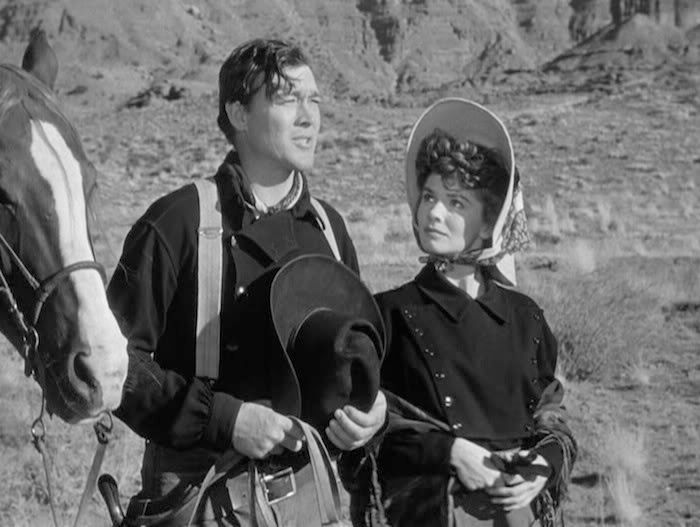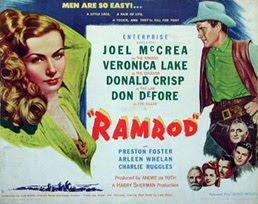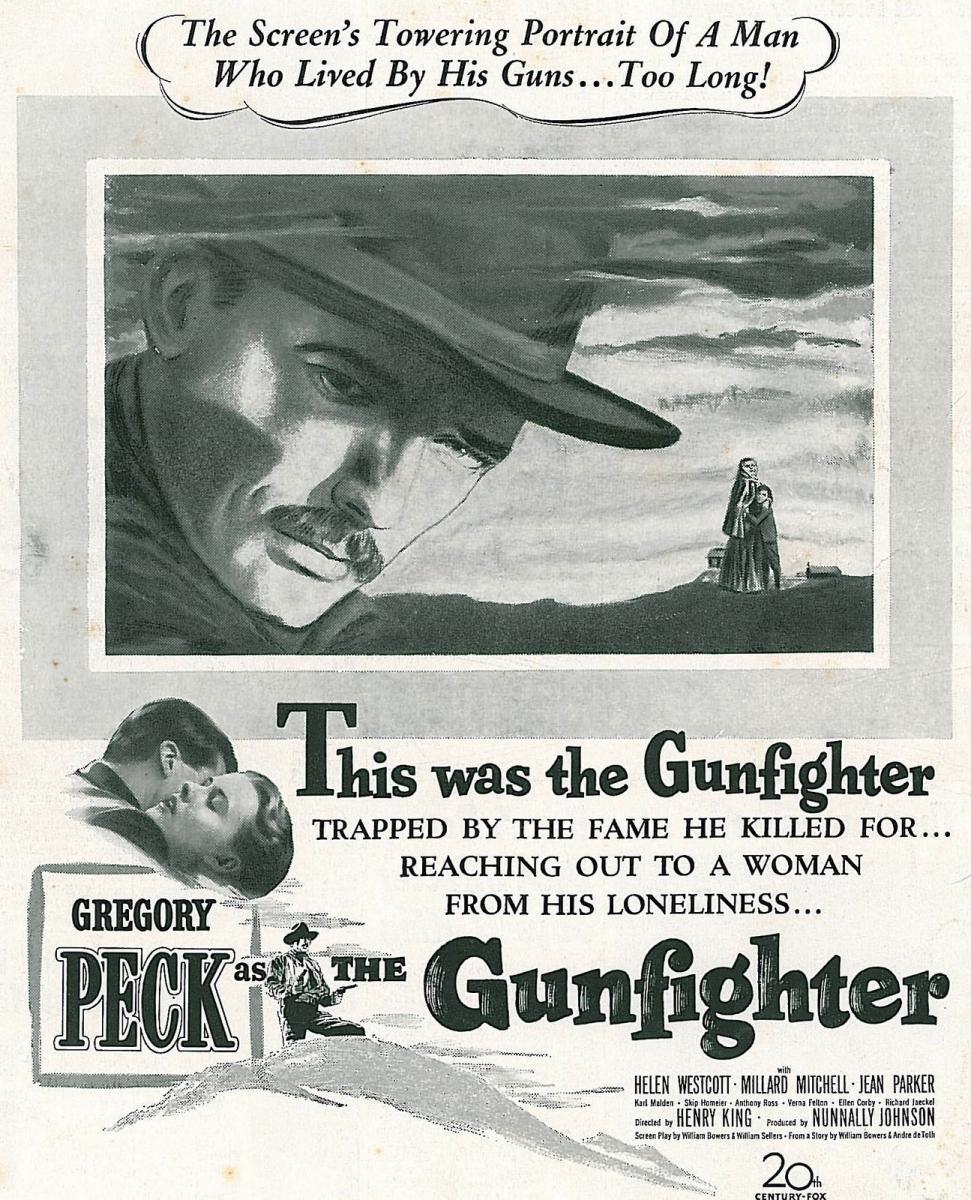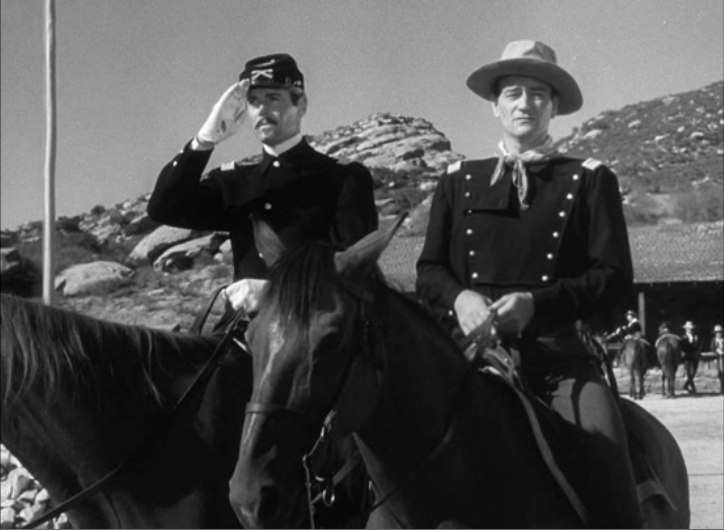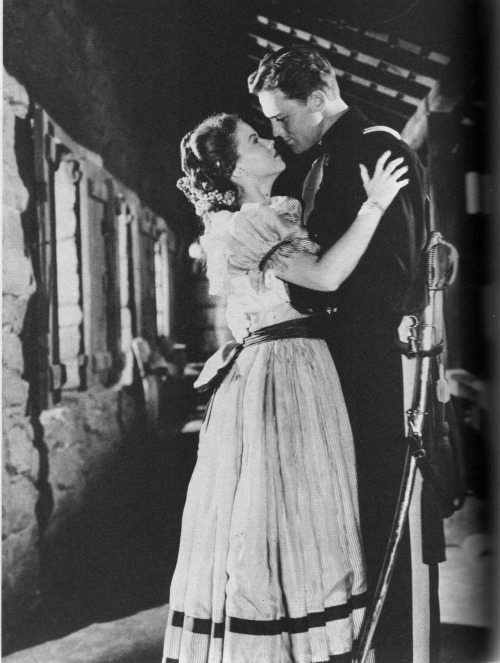At the end of the silent era Universal had Ken Maynard and Hoot Gibson, two of the top movie cowboys, under contract. In 1930, the films of the two cowboys were only part-talking at the beginning of their respective series that year, but by the middle of the year had become all-talking.
 |
| Ken Maynard riding "Tarzan" |
 |
| autographed picture of a very young Hoot Gibson |
Universal, however, like most of the other studios, was not sure what the future held -- especially for films being shot outdoors with the crude sound recording equipment of the day -- and the studio decided that Westerns did not have a future. The decision was made in 1931 to drop the two stars and to discontinue Western film production.
By the following year, some of the technical problems had been eliminated, or at least lessened, and the studio began a series with the most popular silent B-Western cowboy of them all, Tom Mix.
After just one year, Baker was replaced by Johnny Mack Brown, who had starred in a couple of independently produced series and had been gaining popularity starring in Universal's Western serials.
When Mack Brown left for Monogram in 1943, Russell Hayden, who had first gained prominence as Hopalong Cassidy's young sidekick, Lucky Jenkins, joined Ritter, Knight, and Holt to finish out the year.
A new cowboy rode onto the Universal range in 1944. He was a tall, rugged Canadian who was born Nathan Roderick Cox in Calgary, Alberta, but whose stage name was Rod Cameron.
A couple of final notes: when Kirby Grant was dropped by Universal he signed with Monogram and starred in a series of Canadian mountie pictures and then in the 50s he achieved the pinnacle of his popularity when he starred in the SKY KING TV series; and Fuzzy Knight, after continuing to act here and there in movies, also landed on TV in the 50s, supporting Buster Crabbe in CAPTAIN GALLANT OF THE FOREIGN LEGION.
By the following year, some of the technical problems had been eliminated, or at least lessened, and the studio began a series with the most popular silent B-Western cowboy of them all, Tom Mix.
He had been off the screen since 1928 and had been making personal appearances and headlining a circus. The series that was filmed in 1932-33 would be the only series of "talkies" for the aging cowboy, though he would later star in THE MIRACLE RIDER (Mascot), a Western serial that was released in 1935.
 |
| Tom Mix and "Tony" |
When Mix's contract expired Universal turned back the pages of time and re-signed Ken Maynard, who had been busy making Westerns, but had been reduced to working for a Poverty Row independent production company.
His new series would be the best of his career during the sound era, but it would last but one year primarily because he could be a difficult man and soon wore out his welcome.
Maynard was replaced by another famous cowboy star, Buck Jones, who was probably the most popular B-Western star of them all in the early 30s -- and justifiably so. He was a good rider, a good fighter, and, as a bonus, he was one of the best actors to specialize in B-Westerns.
Maynard was replaced by another famous cowboy star, Buck Jones, who was probably the most popular B-Western star of them all in the early 30s -- and justifiably so. He was a good rider, a good fighter, and, as a bonus, he was one of the best actors to specialize in B-Westerns.
 |
| Buck Jones and "Silver" |
After four years, because of conflict with the powers to be at the studio, Jones went back to Columbia, wherehe had made his films prior to signing with Universal.
By this time, Gene Autry (and Dick Foran and Tex Ritter) had made the singing cowboy popular, and Universal decided to replace Jones with singer Bob Baker, who in 1937-38 would star in his only series.
The comedic sidekick had also, sadly in many cases, become almost mandatory for B-Westerns and consequently Fuzzy Knight would fill that role, not only in Baker's films, but until Universal got out of the B-Western business in 1946.
 |
| Bob Baker (born Stanley Leland Weed, nicknamed 'Tumble') with his horse "Apache." Because of the shadows, it isn't apparent, but Apache was a pinto. That's veteran character actor Forrest Taylor to Baker's left. |
After just one year, Baker was replaced by Johnny Mack Brown, who had starred in a couple of independently produced series and had been gaining popularity starring in Universal's Western serials.
He would headline the studio's B-Western series from 1939 to 1943, in what would turn out to be the studio's longest running series.
Baker would be kept on for a year in support of Brown and the two, along with Fuzzy Knight, would comprise a Western trio capitalizing on a format that had been established in the Hopalong Cassidy Westerns at Paramount and The Three Mesquiteers series at Republic.
After one year, Baker would be gone and for the next three years actress Nell O'Day would become the third regular in the series.
 |
| Johnny Mack and "Rebel" |
 |
| Nell O'Day, Johnny Mack, and "Rebel" |
 |
| Fuzzy Knight, Universal's house Western comedic sidekick |
There were significant changes made in the Mack Brown series during its last two years. Jennifer Holt replaced O'Day and the studio reinstated the trio format by adding one of the original singing cowboys, Tex Ritter. In addition, a musical group, the Jimmy Wakely Trio, was added.
When Mack Brown left for Monogram in 1943, Russell Hayden, who had first gained prominence as Hopalong Cassidy's young sidekick, Lucky Jenkins, joined Ritter, Knight, and Holt to finish out the year.
 |
| Jennifer Holt was a member of an acting family. Her father, Jack,, was a Western star during the silent era and a character actor in many Westerns during the sound era. Brother Tim was RKO's last B-Western star. |
 |
| Jack Ingraham has the drop on (L-R) Jennifer Holt, Johnny Mack Brown, and Tex Ritter |
 |
| Tex Ritter and "White Flash" |
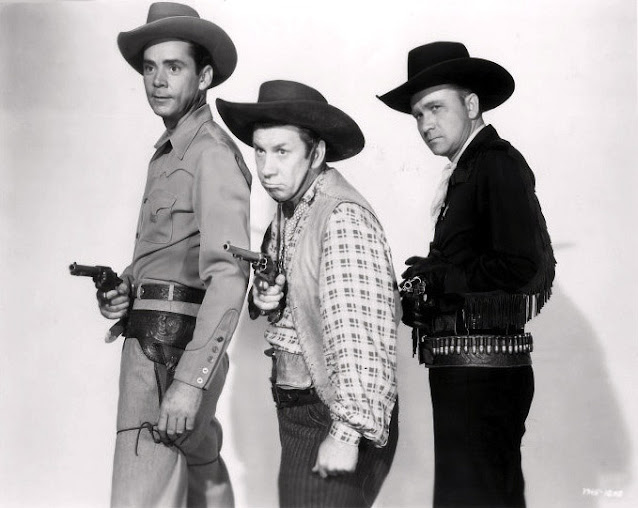 |
| In 1943 Russell Hayden (L) replaced Johnny Mack Brown to form a trio with Fuzzy Knight and Tex Ritter (R) in a short-lived series |
A new cowboy rode onto the Universal range in 1944. He was a tall, rugged Canadian who was born Nathan Roderick Cox in Calgary, Alberta, but whose stage name was Rod Cameron.
He had been knocking
around Hollywood for years doubling and stunting with an occasional bit
speaking role thrown in.
He finally received some notice in 1943 when he starred
in two well-received non-Western serials at Republic. His timing for
once was good, because Universal was looking for a new cowboy and he fit
the bill. He could ride and because of his
stuntman past he could throw a punch and he looked like a cowboy.
Nothing else was expected, but he was a good actor, too.
 |
| Rod Cameron on the left holding a pistol and in the lower right looking through magnifying glass in one of two Republic serials in which he starred in 1943 |
 |
| Rod Cameron, Universal B-Western cowboy |
Fuzzy Knight and Jennifer Holt continued in support and Eddie Dew was added to the regular cast.
Dew had been given his shot at stardom a year earlier when he was paired with comedian Smiley Burnette in the "John Paul Revere" B-Western series at Republic. He failed the test, however, and was replaced by Robert Livingston after only two films.
In fact, he was replaced even before the films were released. He did star in one Universal Western, in all probabililty because Cameron was unavailable at the time.
In the Universal series, Dew would sometimes be an adversary and would other times join Cameron and Knight to form a trio of heroes.
Also added to the cast of regulars was singing cowboy Ray Whitley and his Bar-6 Cowboys. Whitley, best known for writing Gene Autry's theme song, "Back in the Saddle Again," filled a role much like Bob Nolan at Republic and Columbia. He did provide music with his pleasant singing voice, but he also nearly always played an important supporting role, often joining with the hero(es) to round up the outlaws at the end.
By the time film numbers five and six in the series were being made in 1945, Universal had already promoted Cameron to its low-budget A-Westerns (longer-running times and better production values than the B's), the first three co-starring with Yvonne DeCarlo.
In the Universal series, Dew would sometimes be an adversary and would other times join Cameron and Knight to form a trio of heroes.
Also added to the cast of regulars was singing cowboy Ray Whitley and his Bar-6 Cowboys. Whitley, best known for writing Gene Autry's theme song, "Back in the Saddle Again," filled a role much like Bob Nolan at Republic and Columbia. He did provide music with his pleasant singing voice, but he also nearly always played an important supporting role, often joining with the hero(es) to round up the outlaws at the end.
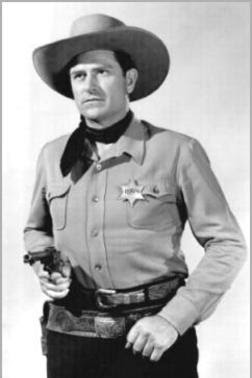 |
| Ray Whitley, singing cowboy |
| There would be only one more Cameron B-Western after this one. |
By the time film numbers five and six in the series were being made in 1945, Universal had already promoted Cameron to its low-budget A-Westerns (longer-running times and better production values than the B's), the first three co-starring with Yvonne DeCarlo.
And he would specialize in low-budget A-Westerns for the remainder of his movie career, though he would occasionally star in a non-Western.
Ten years after he became a B-Western star he hit the jackpot in a film for which I will always remember him: RIDE THE MAN DOWN (Republic, 1953).
Ten years after he became a B-Western star he hit the jackpot in a film for which I will always remember him: RIDE THE MAN DOWN (Republic, 1953).
It was another low-budget A-Western, but it was head and shoulders above nearly all the rest, and certainly the best that Republic ever produced.
Brian Garfield wrote in his fine book, Western films: A Complete Guide, that "RIDE THE MAN DOWN is one those rare little movies in which everybody does everything right. It's strictly traditional, wholly slick-magazine formula, but originality isn't the only hallmark of excellence and movies like this manage to transcend the formula without departing from it....There's nothing arty or profound about it, God knows, but RIDE THE MAN DOWN is a fine example of its genre."
In real life Cameron was an extremely brave man. He proved this when he divorced his wife and married her mother, thus making his ex-wife his stepdaughter. It's enough to make one's head spin.
When Cameron left the B-Western range for greener pastures, Universal found its next cowboy star already under contract. He had been appearing in their B-musicals and comedies.
He was born Kirby Grant Hoon, Jr. in Montana and began his professional career as a singer and bandleader. Along the way he dropped his last name and became Kirby Grant.
In 1944-45, Grant and Fuzzy Knight starred in a series of seven films, with actress Jane Adams replacing Jennifer Holt in most of them. And although Grant had been a professional singer, he, like Bob Baker before him, did not do much singing in his series.
As it turned out, Kirby Grant was the last Universal B-Western star. There would be no more -- unless one counts a series of Western musical shorts starring Tex Williams -- and I don't.
 |
| Brian Donlevy is the star of this film? I don't think so. Look at the poster. |
Brian Garfield wrote in his fine book, Western films: A Complete Guide, that "RIDE THE MAN DOWN is one those rare little movies in which everybody does everything right. It's strictly traditional, wholly slick-magazine formula, but originality isn't the only hallmark of excellence and movies like this manage to transcend the formula without departing from it....There's nothing arty or profound about it, God knows, but RIDE THE MAN DOWN is a fine example of its genre."
In real life Cameron was an extremely brave man. He proved this when he divorced his wife and married her mother, thus making his ex-wife his stepdaughter. It's enough to make one's head spin.
When Cameron left the B-Western range for greener pastures, Universal found its next cowboy star already under contract. He had been appearing in their B-musicals and comedies.
He was born Kirby Grant Hoon, Jr. in Montana and began his professional career as a singer and bandleader. Along the way he dropped his last name and became Kirby Grant.
In 1944-45, Grant and Fuzzy Knight starred in a series of seven films, with actress Jane Adams replacing Jennifer Holt in most of them. And although Grant had been a professional singer, he, like Bob Baker before him, did not do much singing in his series.
As it turned out, Kirby Grant was the last Universal B-Western star. There would be no more -- unless one counts a series of Western musical shorts starring Tex Williams -- and I don't.
+OS.jpeg) |
| Kirby Grant, the last Universal B-Western star |
 |
| Kirby Grant, Jane Adams, Fuzzy Knight |
The studio could take pride in what it accomplished in the B-Western field, their line-up of stars -- Hoot Gibson, Ken Maynard, Tom Mix, Buck Jones, Johnny Mack Brown, and Tex Ritter -- were among the greatest of all the stars in that genre. It may not have been art, but it sure was entertainment.
A couple of final notes: when Kirby Grant was dropped by Universal he signed with Monogram and starred in a series of Canadian mountie pictures and then in the 50s he achieved the pinnacle of his popularity when he starred in the SKY KING TV series; and Fuzzy Knight, after continuing to act here and there in movies, also landed on TV in the 50s, supporting Buster Crabbe in CAPTAIN GALLANT OF THE FOREIGN LEGION.




